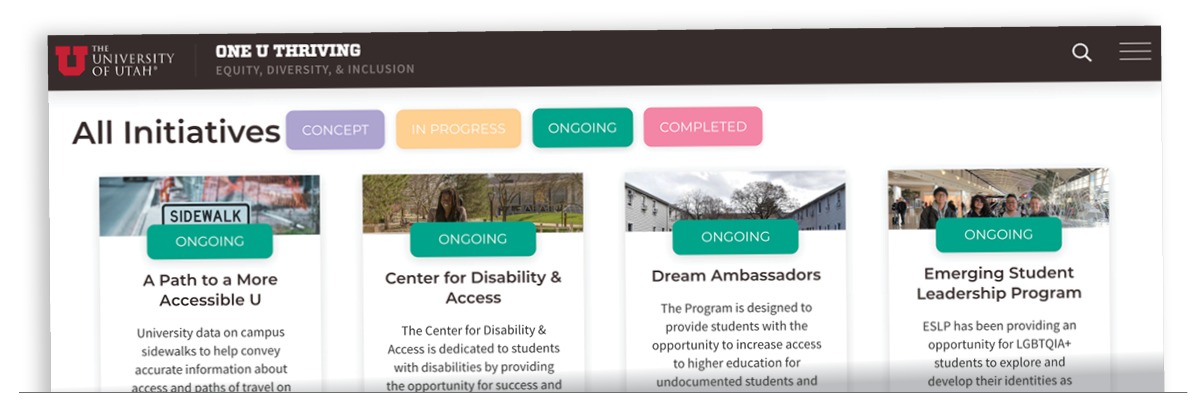University of Utah Sustainability Dashboard
The Sustainability Dashboard is an interactive tool to measure sustainability performance. By better understanding the U's progress over time, members of the U community can identify concerns that propel the institution forward. The Sustainability Office reports these metrics to the Sustainability Tracking, Assessment & Rating System (STARS). In 2021, the University of Utah received a STARS Gold rating. Read the report.
Academics: Curriculum
Sustainability curricular efforts are managed by the Sustainability Education Advisory Committee (SEAC), which is moving the U toward sustainability literacy for every student. SEAC designed the SUSC and SUSL course designations, which are applied to courses that integrate fundamental concepts of sustainability including social, environmental, and economic equity. Additional efforts to incorporate sustainability learning outcomes across campus will ensure students are equipped with the knowledge and skills needed to address local and global challenges.
SUSTAINABILITY Designated Courses
(COMBINED SUSl AND SUSc)
Percentage of Departments with at least one sustainability-related course
Academics: Research
Sustainability research efforts are led by the Global Change & Sustainability Center (GCSC), which is part of the Sustainability Office. Interdisciplinary sustainability research efforts are conducted in nine overlapping themes: air quality; built environment & communities; climate change; ecological & environmental change; energy; food systems; justice, equity, & diversity; nature & culture; and water. Find researchers using the searchable Sustainability Inventory.
Engagement in sustainability research
Percentage of Research departments that conduct Sustainability work
Emissions
The U continues to reduce its emissions, even as the campus adds more students and buildings. Emissions are down overall, thanks to facility upgrades and long-term renewable contracts. The University of Utah tracks Scope 1, 2, and 3 emissions over time. For more information on emissions data over time, contact Facilities Management Sustainability & Energy division.
Emissions in MTCO2e
Progress toward carbon neutrality
31% decline (2021)
In Strategy 2025, the University of Utah committed to achieving a 50% carbon reduction by the year 2025, when compared to its 2007 baseline.
Energy use
Over the past decade, the University of Utah has reduced its energy use per square foot of building space, as well as increased its on-site and off-site renewables totals. Contact the Facilities Management Sustainability & Energy division for more information.
ELECTRICITY BY SOURCE, 2022
In megawatt hours
147,555 mWh
Total geothermal energy purchased by the University of Utah in 2020.
Source Energy Use Intensity (kBtu/sq.ft.)
Source Energy Use Intensity (EUI) is a complete evaluation of a building's energy performance. According to the U.S. Environmental Protection Agency, source energy is the most equitable unit of evaluation because it incorporates transmission, delivery, and production losses.
On-site PV Solar Electricity Production
In megawatt hours
Equity
The University of Utah defines sustainability as the integrated pursuit of environmental integrity, social equity, and economic security. For equity leadership, the Sustainability Office looks to and partners with Equity, Diversity, and Inclusion (EDI), which directs university-wide equity efforts. EDI includes resource centers, offices, and associated student, faculty, and staff affinity groups. EDI tracks campus-wide success with its EDI-In-Progress dashboard.
Funding
Sustainability requires multidisciplinary and interdisciplinary initiatives. Since 2009, the Sustainable Campus Initiative Fund (SCIF), the University of Utah's green grant program, has awarded funding to more than 250 projects that represent a broad spectrum of topics and disciplines.
SCIF Funding by Topic
2009-2021
$1.5 million
Amount awarded by SCIF from 2009-2021
253
Number of projects awarded funding between 2009-2021
13
Number of U colleges that have received SCIF money
Transportation
Sustainable transportation options, both to and within the university, reduce vehicle-related emissions. In 2020, transportation emissions accounted for just over 25% of the university's greenhouse gas emissions. The University of Utah has adopted multiple plans, programs and policies to help balance the region’s transportation network. Learn more about active transportation and other modes of sustainable transportation.
COMMUTE MODE SPLIT BY ROLE
By percentage. Source: 2021 Commuter Survey
University COMMUTE MODE SPLIT
Source: 2021 Commuter Survey
WASTE & RECYCLING
Recycling and waste are managed by the U's Facilities Management department. Data for main campus is reported to the recycling manager. Recycling is important, but the Recycling Manager Josh James stresses that reduction is far more valuable.
Campus diversion
2019 data reported to STARS; includes only main campus and student housing
Focus on reusables
#UBYO (U Bring Your Own) encourages the university community to focus on six reusable items: water bottle, mug, utensils, to-go container, bag, and napkin. Learn more.
Water
The University of Utah is taking significant strides to reduce its water use. The university is installing more efficient toilets and fixtures as part of major renovations and new construction, and Facilities Management has completed significant work to identify and repair leaks. Water-wise landscaping and a major overhaul of the irrigation controls have also led to reductions. The community can help the U's water reduction efforts by reporting broken sprinklers to Facilities Management at 801-581-7221.
Water use reduction per weighted campus user
"Weighted campus user" takes into account the number of students and employees, as well as campus residents



